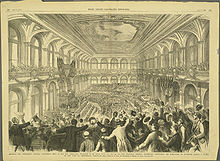38°37′34″N 90°11′15″W / 38.62612°N 90.187379°W

The Merchants Exchange Building was a building at Third Street [1] at Chestnut and Pine in St. Louis, Missouri, from 1875 to 1958, that housed the St. Louis Merchants Exchange and hosted the 1876 Democratic National Convention.
Design and demolition
The building was designed by Francis Lee and Thomas Annan, who placed second in a competition for the structure (the winner was George I. Barnett, but his work was considered too expensive).
The building was the second Merchants Exchange on the location. The first building was built in 1857. During the American Civil War, members of the exchange split along North-South lines. The Exchange merged back together after the war.
The $2 million venue measured 235 by 187 ft (72 by 57 m) by 187 feet (57 m) and was actually two separate buildings. The second and third floors of the western half of the building had an iron truss system that supported the roof and created the largest open indoor space in the United States at the time of its construction (235 feet long and 98 feet (30 m) wide and 65 feet (20 m) tall), and thus was chosen for the 1876 Democratic National Convention, which was the first Democratic or Republican national convention held west of the Mississippi River.
At the same time of its construction, the Merchants Exchange also built the Eads Bridge across the Mississippi River. [2]
The building was torn down in 1957 [3] to make way for the Gateway Arch. [4] Part of the Adam's Mark Hotel was built in its location. In 2008, the Adams Mark announced plans to become a Grand Hyatt.
Merchants' Exchange of St. Louis
The Merchants Exchange founded in 1836 [1] was the first commodity trading exchange in the United States—predating the Chicago Board of Trade. [4]
It was the successor of the city's Chamber of Commerce [1] and articles about the 1876 Convention referred to it as the Chamber of Commerce.
After vacating its downtown location, it was evicted in 1995 from its new location, under the doctrine of eminent domain, when the city expanded the St. Louis Science Center.
The Exchange made a last gasp in 2001 to conduct computerized trading of future trading of freight on the Mississippi and Illinois Rivers. [3] [4] [5] It has quietly ceased operation.
References
- ^
a
b
c Morgan, George H. (September 1911).
"Merchants' Exchange of St. Louis". The Annals of the American Academy of Political and Social Science. 38 (2): 222–223. Retrieved 10 August 2023 – via JSTOR.
It is the legitimate successor of the St. Louis Chamber of Commerce, organised in 1836, and incorporated January, 1837. It owns and occupies a magnificent building, occupying two-thirds of a square, fronting 239 feet on Third Street by a depth of 222 feet. In the western part of the building is located the grand hall, where the daily meetings of the exchange are held, and where business is transacted from 9.30 a.m. to 1.15 p.m.
- ^ Merchants Exchange of St. Louis 1880s - Early Commodity market - Eads Bridge Vignette - scipophily
- ^ a b Shinkle, Peter (25 Nov 2001). "Merchants' Exchange Tries to Make a Comeback". St. Louis Post-Dispatch. p. 24. Retrieved 10 August 2023.
- ^ a b c Allison, Melissa (15 December 2000). "St Louis Exchange Faces Chicago Giants". Chicago Tribune. p. 303. Retrieved 10 August 2023.
-
^ Allison, Melissa (26 May 2002).
"Inside Finance: Bank Notes". Chicago Tribune. pp. 2, Section 5 (Business). Retrieved 11 August 2023.
The once-prestigious Mercantile Exchange of St. Louis was reborn last week as a fully electronic exchange in Chicago, offering future contracts
External links
- Lucas and Garrison's Merchants' Exchange of St Louis
- Morgan, George H (Sept 1911) Merchants' Exchange of St Louis, The Annals of the American Academy of Policy Science Vol. 38, No. 2, American Produce Exchange Markets (Sep., 1911), pp. 222-226
- Photo of the Presidents of the Merchants' Exchange of St Louis, Arista C. Shewey (1892)
- Photo of the Merchants' Exchange Building, W. C. Persons (circa 1929)